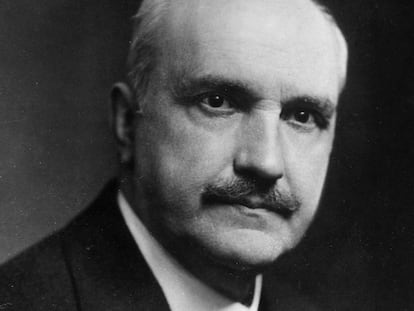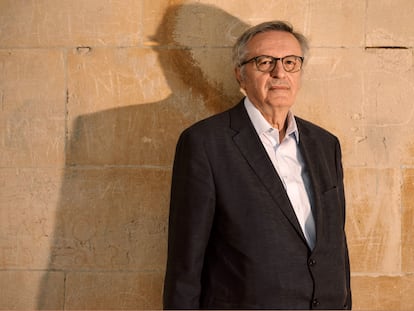George Santayana, the philosopher who authored the aphorism: ‘Those who cannot remember the past are condemned to repeat it’
A new anthology collects the works of the Madrid-born scholar, who grew up in the U.S. and taught at Harvard for two decades


Santayana was a thinker who straddled two worlds, in the vein of Auguste Rodin’s famous sculpture — or so the philosopher Antonio Lastra describes him in the introduction to a new Spanish-language anthology of Santayana’s works: George Santayana: Una antología del espíritu (Fundación Santander, 2023), a collection of essays and lectures from a member of the influential group of Spanish writers, artists and thinkers known as the Generation of ‘98, born in Madrid, educated in Boston, and for two decades, a professor at Harvard University. Santayana (1863-1952), whose works are written entirely in English, never renounced his Spanish nationality. He was a philosopher in no man’s land, thinking day and night about the passage of time and life’s dramatic changes. “Those who cannot remember the past are condemned to repeat it,” he wrote: the aphorism immortalized at the entrance to the Auschwitz extermination camp.
Although Santayana abandoned his Castilian Catholicism, he never completely discarded the role of reason in religion. He consumed Plato’s oeuvre while distancing himself from his ideas, and he ironized about liberalism while embracing its tenets. “The suppression of Santayana’s philosophy is in a way inevitable,” Lastra writes. “But that suppression is no greater than the suppression of his philosophy on the part of those who have always considered him to be essentially Spanish, as though being Spanish were more important than being a philosopher, or as if, operating under some stratagem to say as many non-English things as possible in English, he secretly set out to be a Spanish philosopher who merely happened to write in a different language.” In point of fact, Santayana failed to win a Pulitzer for his only novel, The Last Puritan: A Memoir in the Form of a Novel, because he was not considered truly American, despite his masterful command of the English language, in which he had been trained from the age of seven.
Interestingly, Santayana, who was an unconditional admirer of the Roman Epicurean Lucretius, thought of himself more as a poet than as a philosopher. “In my mental life there have been two great impediments, two congenital vices, two initial temptations: the temptation of the primitive poet to believe in his fables and the temptation of the spontaneous agent to lose himself in the world,” he wrote. Lastra emphasizes that the fact that Santayana “not only wrote in English in a way that no one had ever written in Spanish, but also that he wrote what no one had ever written in Spanish, allows us to read his work while rescuing his philosophy from its repression in Spanish culture. It has, in addition, an unexpected redemptive effect on Spanish culture itself: it is no longer a question of making him into a Spanish philosopher, but of opening Spanish culture up to his philosophy — to a pure, orthodox, humane philosophy.”

Metanoia is a term used by Santayana that means something akin to Christian repentance, and is how one enjoins the sort of conversion or change of heart necessary for becoming a believer — a change of course that tends to occur in response to traumatic thoughts or situations, such as the loss of youth or the death of a loved one. In Santayana’s case, his father’s: “Your ship lies anchored in the peaceful bight / Until a kinder wind unfurl her sail; / Your docile spirit, winged by this gale, / Hath at the dawning fled into the light,” he wrote. In an article published in The Atlantic in 1948, Santayana reflects: “It should he normal, at least according to the ancients, for a philosopher to reach this moral settlement in old age; but why did the idea of it and the need of it come upon me powerfully at the age of thirty? […] My young friends [at Harvard] seemed to me every year younger and younger, more and more standardized and generic. They would no longer be my friends, but only boys at the school where I happened to be one of the masters. That chapter then had come to an end: yet youth, in the world and in the poet’s eyes, is perpetual.”
The relationship between reason and religion, one of Santayana’s constant philosophical concerns, is marked, he writes, by the “catastrophe of the Christian Weltanschauung [worldview] […] if you took it for history or cosmology and not as symbolic myth. And this intellectual catastrophe would also involve a moral one, in that it implied the exhaustion of an inspiration, the decay of a Kultur. […] Each religion, by the help of more or less myth which it takes more or less seriously, proposes some method of fortifying the human soul and enabling it to make its peace with its destiny. A philosopher may perfectly well cultivate more than one Weltanschauung, if he has a vital philosophy of his own to qualify his adoption of each, so as to render them complementary and not contradictory. I had, and have, such a vital philosophy; and the movement of my mind among various systems of belief has tended merely to discover how far my vital philosophy could be expressed in each of them.”
Love, Santayana believes, is “founded on despair.” But “[t]his paradox is condensed and rhetorical; to get at the truth in it we must expand it a little and ward off certain misunderstandings. It is not love simply, but only perfect love, that includes despair. Love in itself includes hope, or at least a desire to preserve the object of it, to enshrine and defend it. And in regard to the object even perfect love retains this solicitude.” A thought he finds not at all incompatible with a defense, or at least an understanding, of the love of money he sees so prominently in the United States. “It is sometimes said that the ruling passion in America is the love of money. That seems to me a complete mistake. The ruling passion is the love of business, which is something quite different.”
A wide-ranging body of work
In his extensive collection of work — in addition to his books, more than 3,000 of the philosopher’s letters have been preserved — Santayana analyzes Christian thought and how, he claims, it “misinterprets facts and conditions.” He writes: “The mythical manner pervades Christian philosophy; but myth succeeds in expressing ideal life only by misrepresenting its history and conditions. This method was indeed not original with the Fathers; they borrowed it from Plato, who appealed to parables himself in an open and harmless fashion, yet with disastrous consequences to his school.”
Concerning Protestants, Santayana argues that their “[r]eligion no longer reveals divine personalities, future rewards, and tenderer Elysian consolations; nor does it seriously propose a heaven to be reached by a ladder nor a purgatory to be shortened by prescribed devotions. It merely gives the real world an ideal status and teaches men to accept a natural life on supernatural grounds.” Thus, he situates himself closer to the Greeks, who “led a rational life and envisaged the various spheres of speculation as men might whose central interests were rational. In physics they leaped at once to the conception of a dynamic unity and general evolution, thus giving that background to human life which shrewd observation would always have descried, and which modern science has laboriously rediscovered.”
Santayana died in 1952 in a hospital and convent run by nuns in Rome. His double being — he considered himself both an atheist and an aesthetic Catholic — would lead him to refuse burial in a Catholic cemetery. The Consulate of Spain ultimately decided that he should be buried at Pantheon of the Obra Pía Española, in the Campo Verano cemetery in Rome, built during the Napoleonic era, but with reminiscences of the ancient empire.
Sign up for our weekly newsletter to get more English-language news coverage from EL PAÍS USA Edition
Tu suscripción se está usando en otro dispositivo
¿Quieres añadir otro usuario a tu suscripción?
Si continúas leyendo en este dispositivo, no se podrá leer en el otro.
FlechaTu suscripción se está usando en otro dispositivo y solo puedes acceder a EL PAÍS desde un dispositivo a la vez.
Si quieres compartir tu cuenta, cambia tu suscripción a la modalidad Premium, así podrás añadir otro usuario. Cada uno accederá con su propia cuenta de email, lo que os permitirá personalizar vuestra experiencia en EL PAÍS.
¿Tienes una suscripción de empresa? Accede aquí para contratar más cuentas.
En el caso de no saber quién está usando tu cuenta, te recomendamos cambiar tu contraseña aquí.
Si decides continuar compartiendo tu cuenta, este mensaje se mostrará en tu dispositivo y en el de la otra persona que está usando tu cuenta de forma indefinida, afectando a tu experiencia de lectura. Puedes consultar aquí los términos y condiciones de la suscripción digital.
More information
Últimas noticias
Most viewed
- Reinhard Genzel, Nobel laureate in physics: ‘One-minute videos will never give you the truth’
- Oona Chaplin: ‘I told James Cameron that I was living in a treehouse and starting a permaculture project with a friend’
- Pablo Escobar’s hippos: A serious environmental problem, 40 years on
- Why we lost the habit of sleeping in two segments and how that changed our sense of time
- Chevy Chase, the beloved comedian who was a monster off camera: ‘Not everyone hated him, just the people who’ve worked with him’










































